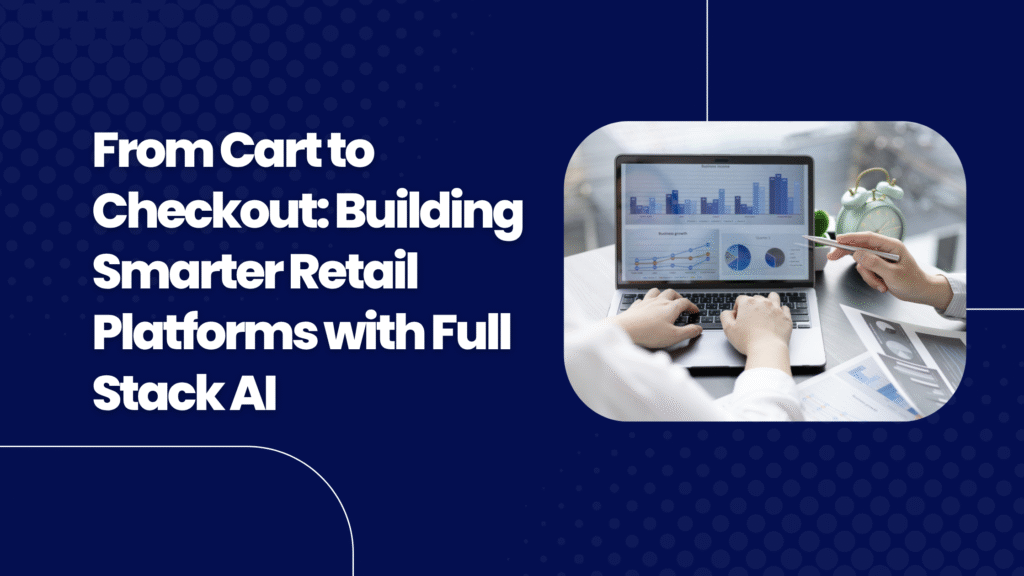
Walk into a physical store and you’re greeted with curated shelves, friendly staff, and a checkout line that—hopefully—moves. In the digital world, that same experience is condensed into pixels and scripts. But there’s a silent complexity powering it all: the transition from browsing to buying, from cart to checkout. And increasingly, the secret sauce is AI—baked directly into the full stack.
We’re not just talking about shiny interfaces or predictive popups. We’re talking about the architecture that quietly enables it all to run smarter, faster, and more tailored than ever. Let’s be honest—retail today isn’t about just being online. It’s about being intelligently online.
So, how do smart retail platforms get built in 2025? The answer: Full stack development fused with AI, working in lockstep from the homepage to the payment gateway.
The New Reality of Retail: Intelligent Expectations
Digital shoppers are sharper than ever. They expect their retail experience to be personal, seamless, and fast. They don’t want to dig. They don’t want to search. And they definitely don’t want to wait.
If the platform doesn’t anticipate what they want, respond quickly, and guide them effortlessly, they’re gone. That’s not drama—it’s data.
Full stack AI development addresses this new reality head-on. Instead of thinking in isolated features, this approach stitches intelligence into the entire experience—from backend databases that learn customer behavior to frontends that reconfigure layouts in real time.
Every step of the user journey, from “just browsing” to hitting “place order,” becomes a finely-tuned, AI-informed interaction.
Full Stack Development: What It Really Means for Retail
Let’s clear something up. Full stack development isn’t about developers doing “a bit of everything.” It’s a holistic approach that integrates front-end presentation, backend logic, APIs, and databases into a unified system.
In retail, that translates to:
-
A product page that loads instantly with AI-ranked suggestions.
-
A backend that recalibrates prices in real time based on demand signals.
-
An inventory system that communicates directly with the UI to show actual, location-specific availability.
-
A secure, smart checkout flow that adapts based on risk signals, user habits, and preferred payment types.
Now, inject AI into every layer, and the entire platform begins to learn. It doesn’t just serve data. It understands the context behind every click.
What AI Brings to Each Layer of the Stack
Frontend (UI/UX)
AI helps tailor user experiences dynamically. Think of interfaces that rearrange themselves depending on the shopper’s browsing style. If someone always searches by filter, the filter panel gets more prominent. If they scroll instead of search, the layout prioritizes visuals over search bars.
Backend (Logic & Services)
Here’s where AI quietly does the heavy lifting. It manages pricing strategies, availability predictions, and customer segmentation. Imagine an AI model that adjusts shipping options in real time based on local delivery partner delays—without human intervention.
Databases & Storage
A smart stack uses AI not just for data retrieval, but for data intelligence. It flags inconsistencies in product listings, identifies top-converting bundles, and optimizes product metadata for search.
APIs and Integrations
AI helps optimize traffic routing between services. If your storefront connects to recommendation engines, payment gateways, loyalty platforms, and CRM tools—AI ensures that those connections stay fast, lean, and relevant to each customer session.
This is what it means to be AI-native, not just AI-aware.
Real Results: What Retailers Are Gaining
Let’s cut to brass tacks—what do businesses actually get from investing in AI-powered full stack retail platforms?
-
Increased Conversion Rates: A major U.S. electronics retailer saw a 32% increase in conversions after switching to an AI-enhanced stack that re-ordered product listings in real time based on customer profiles.
-
Reduced Abandonment: An Australian fashion brand used AI to identify friction points in its checkout process. After automating personalized nudges and streamlining payment authentication, cart abandonment dropped by 19%.
-
Smarter Inventory Turnover: A global grocery delivery service integrated AI into its backend stack. Based on browsing behavior and time-of-day trends, it suggested fresh produce combinations that improved upsells—and slashed spoilage rates by nearly 40%.
This isn’t experimental anymore. These are structural wins.
From Discovery to Purchase: A Fully AI-Orchestrated Journey
Let’s walk through what an AI-enhanced full stack retail experience actually looks like.
Discovery: A new user lands on your site. AI compares their IP, device type, and referral link to prior sessions. The home page loads with a different layout—optimized for mobile scrollers or desktop planners.
Browsing: As the user scrolls, the product grid reorders. Products that match recent search trends, local availability, and even weather data (yes, that’s a thing) float to the top.
Carting: When items are added to the cart, the system silently checks delivery routes, warehouse stock, and possible coupon codes. It suggests personalized bundles—based not just on what’s popular, but what’s relevant.
Checkout: The payment screen adapts. AI detects this is a returning customer using a secure network. The one-click payment option appears, bypassing redundant authentication. The process completes in seconds.
What just happened wasn’t magic. It was full stack intelligence at play—unobtrusive but powerful.
The Retail Tech Shift: From Reactive to Proactive
In the old world, retail platforms were built to respond. Show what the customer asked for. Deliver what was in stock. Offer promotions based on quarterly plans.
Now, platforms are expected to anticipate. Before the customer clicks, the system should already have a hunch.
Full stack AI enables this shift:
-
It predicts what users want.
-
It prepares the infrastructure to support demand.
-
It personalizes in the moment, not in hindsight.
That’s a profound change. It requires different thinking, different engineering, and a development mindset that treats AI as a partner, not an add-on.
What Developers Need to Know (and Do Differently)
Today’s full stack developers can’t just be fluent in JavaScript or database queries. They need to think like product strategists, data analysts, and experience designers—often all at once.
Here’s what smart development teams now prioritize:
-
Context-aware APIs: APIs that don’t just send data, but adapt to the user’s journey.
-
Edge computing with AI: Deploying microservices closer to the user, minimizing latency, and tailoring experiences geographically.
-
Real-time data modeling: Feeding ML models not monthly reports, but second-by-second streams of behavior.
-
Security-as-intelligence: Building fraud detection and verification systems that evolve with user behavior, not static rules.
This is the difference between building a store and building a platform that learns.
Challenges You Shouldn’t Ignore
Let’s not sugarcoat this. Full stack AI for retail isn’t a walk in the park.
-
Data Cleanliness: Garbage in, garbage out. AI is only as smart as the data you feed it. Retailers need clean, structured, and properly labeled data.
-
System Complexity: More intelligence means more interdependencies. If one microservice breaks, it can ripple through the stack. Monitoring, alerting, and redundancy are critical.
-
Ethics and Transparency: Personalized pricing? AI-based promotions? These can be powerful—and controversial. Developers must build in accountability and offer user clarity.
Ignore these, and even the smartest tech won’t save you.
Why Now? The Market Has Moved
Three years ago, AI in retail was a headline. Today, it’s the infrastructure.
Consumers expect smarter experiences. Retailers that don’t deliver them don’t just lose sales—they lose credibility. Even smaller eCommerce players are adopting intelligent stacks through platforms like Shopify’s Hydrogen, Vue Storefront with AI plugins, and serverless cloud frameworks optimized for dynamic personalization.
Full stack AI isn’t the future. It’s the new standard.
Conclusion: Smart Retail Begins with Smarter Stacks
From cart to checkout, there’s a new rhythm in retail. It’s not about being faster or flashier. It’s about being more aware—of the customer, of the moment, and of the context.
That awareness isn’t accidental. It’s engineered—through full stack development fused with AI.
To deliver personalized, scalable, and responsive retail platforms today, businesses need more than surface-level tech. They need systems designed to listen, learn, and adapt in real time.
And that starts with working with a full stack web development company that understands not just the code, but the intelligence that needs to drive it.
Retail is evolving—quietly, quickly, and radically. Are you building for it?




